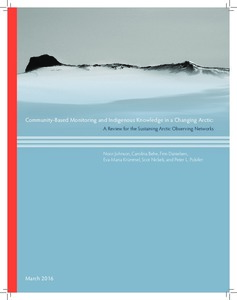| dc.contributor.author | Johnson, Noor | |
| dc.contributor.author | Behe, Carolina | |
| dc.contributor.author | Danielsen, Finn | |
| dc.contributor.author | Krümmel, Eva-Maria | |
| dc.contributor.author | Nickels, Scot | |
| dc.contributor.author | Pulsifer, Peter L. | |
| dc.coverage.spatial | Arctic Region | en_US |
| dc.date.accessioned | 2020-04-29T21:33:01Z | |
| dc.date.available | 2020-04-29T21:33:01Z | |
| dc.date.issued | 2016 | |
| dc.identifier.citation | Johnson, N.; Behe, C.; Danielsen, F.; Krümmel, E.M.; Nickels, S. and Pulsifer, P.L. (2016) Community-Based Monitoring and Indigenous Knowledge in a Changing Arctic: A Review for the Sustaining Arctic Observing Networks. Final report to Sustaining Arctic Observing Networks. Ottawa, Canada : Inuit Circumpolar Council, 65pp. DOI: http://dx.doi.org/10.25607/OBP-822 | en_US |
| dc.identifier.uri | http://hdl.handle.net/11329/1314 | |
| dc.identifier.uri | http://dx.doi.org/10.25607/OBP-822 | |
| dc.description.abstract | This review of community-based monitoring (CBM) in a
changing Arctic is based on a multi-year initiative launched
in 2012 as a task under the “Sustaining Arctic Observing
Networks” (SAON), a network of Arctic observing networks.
The goal of the task was to better understand the current state
of CBM in the Arctic, with a particular interest in monitoring
and observing based on Indigenous Knowledge (IK), and to
make recommendations to SAON and the Arctic observing
community more broadly about how to support engagement
and development of CBM.
The task began with the creation of a searchable, online
inventory of CBM and IK programs, projects, and initiatives:
the Atlas of Community-Based Monitoring and Indigenous
Knowledge in a Changing Arctic (www.arcticcbm.org). The
Exchange for Local Observations and Knowledge of the Arctic
(ELOKA) developed this web-based atlas infrastructure on
the Nunaliit Atlas Development Framework (http://nunaliit.
org). The Atlas geolocates these various initiatives, visualizes the
networks of communities that are involved, and shares metadata provided or verified by program staff.
Identification and recruitment of CBM and IK initiatives
to join the Atlas involved a number of strategies. We intentionally did not pre-define CBM, but adopted an inclusive
approach that encompassed programs with different levels of
community involvement as well as IK projects with relevance
to long-term observing. We conducted initial outreach to a number of Indigenous organizations and government and
academic researchers engaged in monitoring and observing
activities. At the pan-Arctic level, Arctic Council Permanent
Participants (PPs), and the SAON and Conservation of Arctic
Flora and Fauna (CAFF) boards were briefed and asked to
refer programs. Once programs were identified, program staff
were asked to fill out a questionnaire to provide metadata
about their initiative. In some cases, phone interviews were
conducted and program staff were asked to approve a pre-filled
questionnaire. Completed questionnaires were reviewed and
entered into the Atlas by a trained member of the research
team to ensure consistency of entries. As of September 2015,
the Atlas included 81 program entries.1
The second component of the SAON task was to analyze these
entries alongside information gathered from participation of
several of this review’s authors in a series of workshops on CBM
and IK held in 2013 and 20142
; this analysis informed the
development of the review. The goal of the review is to provide
a snapshot of the methods, approaches, and practices of CBM
and IK initiatives, and to present recommendations for next
steps in supporting the continued development of CBM as an
important approach to Arctic observing. The intended audience of this review includes CBM and IK program practitioners and interested community members, scientists and researchers
interested in different approaches to Arctic observing, individuals engaged in developing approaches and networks for data
sharing and coordination, and municipal, state/territorial, and
national government agencies interested in community-based
approaches to monitoring. The review contains the following
sections: General overview of programs in the Atlas; Specific
issue areas; Good practices; and Next Steps. | en_US |
| dc.description.sponsorship | This review was produced with support from Brown University’s Voss Interdisciplinary Postdoctoral Fellowship, the Nordic
Council of Ministers, the European Commission, and the National Science Foundation under grant numbers ARC 0856634 and
ARC 1231638. | en_US |
| dc.language.iso | en | en_US |
| dc.publisher | Inuit Circumpolar Council | en_US |
| dc.subject.other | Community based monitoring (CBM) | en_US |
| dc.subject.other | Indigenous communities | en_US |
| dc.subject.other | Indigenous knowledge | en_US |
| dc.title | Community-Based Monitoring and Indigenous Knowledge in a Changing Arctic: A Review for the Sustaining Arctic Observing Networks. Final report to Sustaining Arctic Observing Networks. | en_US |
| dc.type | Report | en_US |
| dc.description.status | Published | en_US |
| dc.format.pages | 65pp. | en_US |
| dc.description.refereed | Refereed | en_US |
| dc.publisher.place | Ottawa, Canada | en_US |
| dc.subject.parameterDiscipline | Parameter Discipline::Physical oceanography | en_US |
| dc.subject.parameterDiscipline | Parameter Discipline::Environment | en_US |
| dc.subject.parameterDiscipline | Parameter Discipline::Administration and dimensions::Administration and dimensions | en_US |
| dc.description.currentstatus | Current | en_US |
| dc.description.sdg | 14.2 | en_US |
| dc.description.sdg | 14.7 | |
| dc.description.bptype | Manual (incl. handbook, guide, cookbook etc) | en_US |
| obps.contact.contactemail | Noor.Johnson@colorado.edu | |
| obps.resourceurl.publisher | http://www.arcticcbm.org/ | en_US |
 Repository of community practices in Ocean Research, Applications and Data/Information Management
Repository of community practices in Ocean Research, Applications and Data/Information Management
